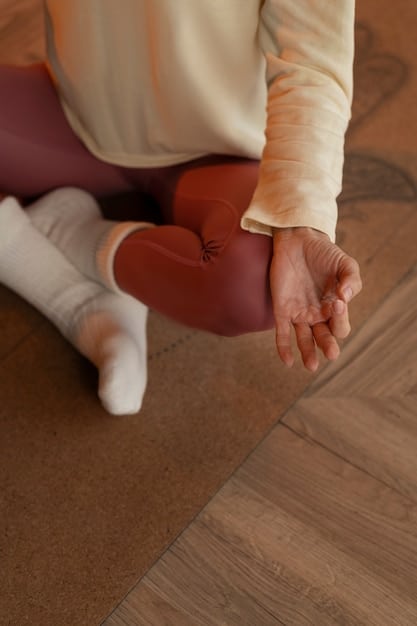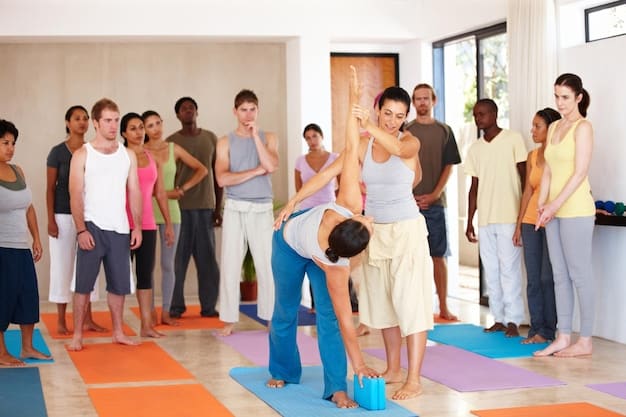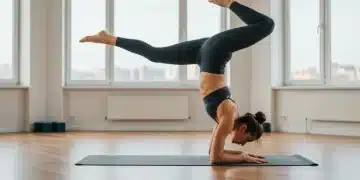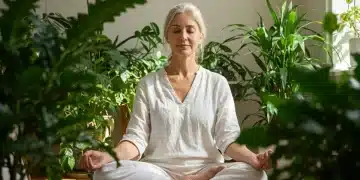Meditation vs. Yoga: Find the Best Stress Relief for You

Meditation and yoga are both effective stress-relief techniques, but they differ in their approach; meditation focuses on mental calmness through focused breathing, while yoga combines physical postures, breathwork, and mindfulness to reduce stress and enhance overall well-being.
Feeling stressed? Both meditation and yoga are popular ways to find some peace, but which one is right for you? This guide offers a comparison/analysis: meditation vs. yoga: which stress-relief technique is right for you? to help you decide.
Understanding Meditation
Meditation is a practice that trains your mind to focus and redirect your thoughts. It involves achieving a mentally clear and emotionally calm state. There are many types of meditation, each with its unique approach, but all aim to promote relaxation and reduce stress.
At its core, meditation is about observing your thoughts and feelings without judgment. It’s a mental exercise that helps you become more aware of your inner state, allowing you to respond to stress with greater equanimity.
Different Types of Meditation
Meditation is not a monolithic practice. Several techniques cater to different preferences and needs.
- Mindfulness Meditation: Involves paying attention to your thoughts, feelings, and bodily sensations in the present moment without judgment.
- Transcendental Meditation: Uses a mantra, a specific sound or word, to quiet the mind and promote relaxation.
- Guided Meditation: Involves listening to a teacher or recording that guides you through visualizations and relaxation techniques.
These are just a few examples, and exploring them can help you find the method that resonates best with you. Each offers a unique pathway to inner peace and stress reduction.

By understanding meditation, you can start to incorporate these techniques into your daily life, reducing stress and improving overall well-being. The key is to find what works for you and commit to regular practice.
The Essence of Yoga
Yoga is an ancient practice that combines physical postures (asanas), breathing techniques (pranayama), and meditation (dhyana). It’s a holistic approach to health that aims to unite the mind, body, and spirit. Yoga is not just about physical exercise; it’s a comprehensive system for well-being.
The physical postures in yoga help improve flexibility, strength, and balance, while the breathing techniques calm the nervous system and promote relaxation. The meditative aspect of yoga encourages mindfulness and inner peace.
The Different Branches of Yoga
Like meditation, yoga has many different styles or branches, each with its unique focus and intensity.
- Hatha Yoga: A gentle and foundational style that is suitable for beginners. It emphasizes basic postures and breathing techniques.
- Vinyasa Yoga: A more dynamic style that links movement with breath, creating a flowing sequence of poses.
- Ashtanga Yoga: A rigorous and structured style that follows a specific sequence of poses, building strength and endurance.
Choosing a yoga style depends on your fitness level, preferences, and goals. Whether you seek relaxation, strength, or spiritual growth, there’s a yoga style to match your needs.
Yoga offers a comprehensive approach to stress relief by integrating physical activity, breath control, and mindfulness. Its diverse styles make it accessible to people of all ages and fitness levels.
Stress Relief: Meditation vs. Yoga
Both meditation and yoga are proven stress-relief techniques, but they work in different ways. Meditation primarily targets the mind, calming the nervous system and reducing mental chatter. Yoga works on both the mind and body, releasing physical tension and promoting mental clarity.
When considering comparison/analysis: meditation vs. yoga: which stress-relief technique is right for you?, it’s important to consider your personal preferences and needs. Do you prefer a more active or passive approach to stress relief?
How Meditation Reduces Stress
Meditation reduces stress by slowing down the heart rate, lowering blood pressure, and decreasing the production of stress hormones like cortisol. It also enhances the ability to focus and manage overwhelming thoughts and emotions.
- Calming the Mind: Meditation allows you to observe your thoughts without getting carried away by them, creating a sense of detachment and inner peace.
- Reducing Anxiety: Regular meditation can reduce anxiety by training the mind to stay present and less focused on future worries.
- Improving Sleep: Meditation can improve sleep quality by relaxing the body and mind, making it easier to fall asleep and stay asleep.
Meditation offers a simple yet powerful way to manage stress and promote mental well-being. It requires minimal equipment and can be practiced anywhere, making it an accessible stress-relief tool for busy individuals.

Yoga’s multifaceted approach to stress relief makes it a valuable tool for enhancing overall well-being. It’s not just about physical fitness; it’s about cultivating a deeper connection with yourself.
Physical Benefits: Yoga’s Edge
While meditation is primarily a mental exercise, yoga offers a range of physical benefits. The physical postures in yoga improve flexibility, strength, balance, and cardiovascular health. These physical benefits can contribute to stress reduction and overall well-being.
Yoga’s physical aspect also makes it an excellent option for people who find it difficult to sit still and meditate. The movement can help release pent-up energy and physical tension, making it easier to relax and focus.
Flexibility and Balance
Yoga postures stretch and lengthen muscles, improving flexibility and range of motion. They also challenge your balance, enhancing stability and coordination.
- Improved Posture: Yoga strengthens core muscles and improves body alignment, leading to better posture and reduced back pain.
- Increased Energy Levels: Regular yoga practice can increase energy levels by stimulating circulation and releasing blockages in the body.
- Pain Relief: Yoga can alleviate chronic pain conditions like arthritis and fibromyalgia by reducing inflammation and improving joint mobility.
These physical benefits of yoga can have a profound impact on your overall quality of life. By improving physical health, yoga can also enhance mental and emotional well-being.
Yoga offers a comprehensive approach to health by integrating physical activity with mindfulness and relaxation. Whether you seek stress relief, physical fitness, or spiritual growth, yoga can be a valuable practice for enhancing overall well-being.
Mental and Emotional Benefits: A Close Look
Both meditation and yoga offer significant mental and emotional benefits, but they achieve these benefits in slightly different ways. Meditation cultivates mental clarity and emotional calmness, while yoga balances the mind and body, promoting a sense of harmony and well-being.
When evaluating comparison/analysis: meditation vs. yoga: which stress-relief technique is right for you?, consider your mental and emotional needs. Are you seeking to quiet your mind, manage your emotions, or cultivate a deeper sense of self-awareness?
Emotional Regulation
Meditation and yoga both teach you to observe your emotions without judgment, allowing you to respond to them with greater equanimity.
- Increased Self-Awareness: Regular practice enhances your ability to recognize and understand your emotions, leading to greater self-awareness and emotional intelligence.
- Reduced Reactivity: Meditation and yoga can reduce reactivity to stress by training the mind and body to stay calm in challenging situations.
- Improved Mood: Both practices can improve mood by increasing the production of endorphins, natural mood boosters that alleviate anxiety and depression.
By fostering emotional regulation, meditation and yoga can help you navigate life’s challenges with greater resilience and inner peace. They provide tools to manage stress, improve mood, and cultivate a deeper sense of self-awareness.
By improving mental and emotional well-being, meditation and yoga can enhance your overall quality of life. They offer pathways to inner peace, resilience, and self-discovery.
Ease of Access and Time Commitment
One of the key considerations when choosing between meditation and yoga is the ease of access and time commitment required. Meditation is generally easier to access and requires less time than yoga. You can meditate anywhere, anytime, with minimal equipment or instruction.
Yoga, on the other hand, often requires a class or studio, which can be less accessible for some people. However, online yoga classes and tutorials have made it easier to practice yoga at home. The time commitment for yoga can also vary depending on the style and duration of the class.
Getting Started with Meditation
Meditation is incredibly accessible to beginners. You can get started with a few simple techniques and minimal equipment.
- Find a Quiet Space: Choose a quiet and comfortable place where you can sit or lie down without distractions.
- Focus on Your Breath: Pay attention to the sensation of your breath as it enters and leaves your body.
- Start with Short Sessions: Begin with 5-10 minute sessions and gradually increase the duration as you become more comfortable.
Meditation can be easily integrated into your daily routine, whether it’s during your morning commute, lunch break, or before bed. Its accessibility makes it a convenient and effective stress-relief technique for busy individuals.
Meditation and yoga both offer valuable tools for managing stress and improving well-being. By considering your preferences, needs, and lifestyle, you can choose the technique that best fits your unique path to inner peace.
| Key Aspect | Brief Description |
|---|---|
| 🧘 Meditation | Focuses on mental clarity and reducing stress through techniques like mindfulness. |
| 🤸 Yoga | Combines physical postures, breathing exercises, and meditation for overall well-being. |
| ⏱️ Time Commitment | Meditation can start with 5-10 minutes, while yoga sessions often range from 30-90 minutes. |
| 💪 Physical Benefits | Yoga offers physical benefits like improved flexibility and balance, whereas meditation’s focus is primarily mental. |
Frequently Asked Questions
▼
Yes, absolutely! Integrating both meditation and yoga into your routine can provide a well-rounded approach to stress relief and overall well-being. They complement each other effectively.
▼
Both can be beneficial. Meditation helps calm the mind, while yoga releases physical tension and improves mood. The “better” choice depends on individual preferences and needs.
▼
Aim for at least 3-5 times per week for both practices. Consistency is key to experiencing their full benefits. Even short, regular sessions can make a significant difference.
▼
Meditation requires minimal equipment – just a quiet space. Yoga may benefit from a mat, but it’s not always necessary. Comfortable clothing is recommended for both activities.
▼
Yes, both are beginner-friendly. Start with basic techniques and gradually progress. Many online resources and classes cater specifically to beginners in both meditation and yoga.
Conclusion
In conclusion, both meditation and yoga offer effective ways to manage stress and improve overall well-being. The best choice depends on your individual preferences, needs, and lifestyle. Whether you prefer the mental focus of meditation or the physical activity of yoga, incorporating either practice into your daily routine can bring profound benefits to your mind and body.





